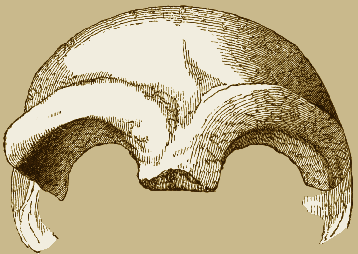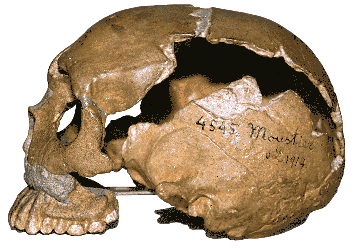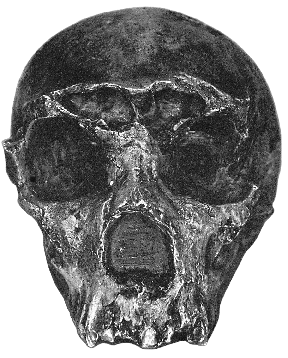|
.
Phase 1: Acceptance of Evolutionary Theory and Human Antiquity
1823: Goat's Hole, Paviland, Wales: Rev. William Buckland discovers
the post-cranial skeleton of anatomically modern human (Homo sapiens),
covered in ochre and associated with shells and ivory jewelry. Known as
“Red Lady of Paviland” (although later revealed to be male) it
was the earliest human fossil yet recognized.
1830: Engis Cave, Belgium: Phillipe-Charles Schmerling discovers the
crania of a 2-3 year old Neanderthal child. The first Neanderthal uncovered,
it was not recognized as such until 1936.
1848: Forbes Quarry, Gibraltar: discovery of a skull. One of most
complete Neanderthal crania ever found, it was recognized in 1863 by George
Busk as similar in form to the skull from the Neander Valley.
1853: St. Acheul, France: Dr. Rigollot discovers stone handaxes in
association with bones of extinct mammals, thus attesting to their great
age.
1856: Feldhofer Grotto, Neander Valley, Germany: Joh ann Karl Fuhlrott
first recognizes the fossil called “Neanderthal man.” The bones
included a cranium as well as several long bones, some of which showed signs
of injury, thus opening up doubt that this was mere- ly a diseased individual,
rather than a separate type of human. ann Karl Fuhlrott
first recognizes the fossil called “Neanderthal man.” The bones
included a cranium as well as several long bones, some of which showed signs
of injury, thus opening up doubt that this was mere- ly a diseased individual,
rather than a separate type of human.
Fig.1: Neanderthal cranium from Feldhofer Grotto, Germany (Huxley 1863).
.1859: On the Origin of the Species published by Charles Darwin. Together with
work by Alfred Russel Wallace, this book provided the mechanism of natural
selection to evolutionary theory.
1863: The species Homo neanderthalensis: proposed by William
King. At the meeting of the British Assoc. for the Advancement of Science,
King declares that the Feldhofer skull rep resents a separate species of the genus Homo. 1863:
Thomas Henry Huxley, meanwhile, identifies the Feldhofer Neanderthal cranium (fig.1) as well as a skull from Ennis, Belgium as
similar to, and likely ancestral to, those of modern humans.
1866: Trou de La Naulette Cave, Belgium: Edouard Dupont discovers
a mandible (lower jaw), ulna (one of two forearm bones) and metacarpal
(hand-bone) in association with bones of extinct animals. First Neanderthal
remains to be generally accepted as of great antiquity and different anatomy
than modern humans.
Phase 2: Neanderthals: Our Ancestors?
1867: Gabriel de Martillet subdivided the Paleolithic into phases
named after type-sites: -1873 Magdalenian (most recent), Aurignacian, Solutrean,
Mousterian, Acheulean, and Chellean. Although modified, most of these phases
are still recognized today.
1868: Cro Magnon Cave, Dordogne, France: Discovery of six Homo
sapiens skeletons. These anatomically modern human remains, found with
Aurignacian stone tools, carved reindeer antlers, ivory pendants, and pierced
shells, established the antiquity of modern humans (fig.1).
1868: Ernst Haekel: proposed a human phylogeny or evolutionary sequence.
His evolu- tionary tree shows a single lineage from apes to a hypothetical
ancestor, Pithecanthropus alalus (“apeman without
speech”).
1874: Pontnewydd, Wales: Discovery of Neanderthal fossils.
1876: Rivaux, S. France: Discovery of Neanderthal fossils.
1880: Šipka, Moravi: Karel Maška. The lower jaw or mandible
of a Neanderthal child was found in a secure context, associated with cultural
debris, including hearths, Mousterian tools, and bones of extinct
animals.
1886: Betche-aux-Rotches cave, Spy d'Orneau, Belgium: Marcel de Puydt
& Max Lohest find two nearly complete Neanderthal skeletons in association
with Mousterian tools. The publication of these remains established Neanderthals
as a separate type of ancient human, rather than pathological modern humans.
Unfortunately, the limb-bones were misinter- preted as indicating that
Neanderthals walked with bent knees in an ape-like posture. .
Phase 3: Looking Further Backward on the Evolutionary Tree
1891: Trinil, Java, East Indies: Eugene Dubois finds skull and leg
bones of “Java Man,” the first Homo erectus, then called
Anthropopithecus javenensis or Pithecanthropus.
1899: Krapina, Croatia: Karl Gorjanovic-Kramberger discovers a human
molar, leading to extensive excavation of the site under a systematic plan,
so that hundreds of Neanderthal bones (up to 70 individuals) were described
in stratigraphic position in association with cultural remains and extinct
animal bones.
1906:
Gorjanovic-Kramberger's publication of finds from Krapina claimed great antiquity
(127-73,000 years ago) for the Neanderthals, and their direct ancestry to
Homo sapiens, but also was first to propose that Neanderthals were
cannibalistic.
1907: Gibraltar skull: William Sollas analyzed skull (from 1840);
recognized it as Neanderthal.
1907: Mauer, near Heidelberg, Germany: Joseph Rosch discovers an enigmatic
ma ndible studied by Otto Schoetensack, who claimed that Homo
heidelbergensis were more ancient than Neanderthals. ndible studied by Otto Schoetensack, who claimed that Homo
heidelbergensis were more ancient than Neanderthals.
1908: Le Moustier rockshelter, southwest France: Otto Hauser discovers
a complete Neanderthal skeleton within a “burial” (all but the
skull later lost in World War II).
Fig.2: Neanderthal cranium from Le Moustier,
France (Athena Review, from cast at AMNH).
1908: La Chapelle-aux-Saints, France. Amédée and Jean
Bouyssonie, and Bouffia Bonneval discover a nearly complete Neanderthal skeleton
in association with Mousterian tools and bones of extinct tools. Claimed
by Marcellin Boule to have been intentionally buried.
1908: Piltdown Man “discovered” by Charles Dawson in England.
The pairing of a modern human cranium and a stained, broken orangutan jaw
confimed expectations of a human ancestor with a large, rounded braincase.
The forgery confused paleoanthropology for many years and pushed Neanderthals
to a side branch of human evolution.
1909: La Ferrassie, Dordogne, France: Denis Peyron discovers adult
male and female -1910 Neanderthal skeletons, followed in later years by isolated
bones of five children.
1910: La Quina Rock shelter, France: Henri Martin finds remains of
two Neanderthals in conjunction with Mousterian tools (“Quina
scrapers”).
1911-1913: Marcellin Boule’s article in Annales de
Paléontologie establishes paleoanthropology as a discipline. His
description of the skeleton from La Chapelle lead to the image of Neanderthals
as primitive and apish with stooping posture, slouching gait, forward- thrusting
head, bent knees and divergent big toe.
1921: Broken Hill, Northern Rhodesia (Zambia):Discovery of Middle
Paleolithic skull. The first Neanderthal-like fossil discovered outside Europe,
“Rhodesian Man” was analyzed by Arthur Smith Woodward.
1924: Taung Cave, South Africa: Raymond Dart finds first Australopithecus
including a skull and endocast (fossilized replica) of child’s brain.
Named Australopithecus africanus by Dart, who considered the “Taung
Baby” a “missing link” between humans and apes, his conclusions
(now influential) were largely rejected by the scholarly community.
1925: Zuttiyeh Cave , near Sea of Galilee: Francis Turville-Petre
finds fossilized upper face of a Neanderthal, known as “Galilee
Man.”
1926: Devil's Tower Cave, Gibraltar: Dorothy Garrod discovers
skull of a Neanderthal child. .
Phase 4: Back in the Fold: Neanderthal as a Human Mirror
1927: Aleš Hrdlicka proposes Neanderthals as an evolutionary
stage in lineage of humankind.
1927: Choukoutien (Zhoukodien), near Bejing, China: Davidson Black
discovers a molar, and later a skull, of Sinanthropus pekinensis
(“Peking Man”), now recognized as an example of Homo erectus
from about 300,000 BP.
1929:
Saccopastore quarry at Rome, Italy: Discovery of partial Neanderthal cranium
(fig.3).
Fig.3: skull found at Saccopastore (Athena Review, from
cast at AMNH).
1930: Mount Carmel, Israel: Dorothy Garrod excavates Neanderthal and
early mod- -1932 ern human remains along with plentiful tools in Carmel Caves
(el-Wad, el-Tabun, es- Skhul). These were then combined as one
“Neanderthalians” species by Arthur Keith.
1931: Solo River terrace, Ngandong, Java: W.F.F. Oppenoorth discovers
several brain-1933 cases interpreted as “tropical Neanderthals.”
Debate continues on the interpretation of these finds, recently dated to
c. 40,000 BP., which show close resemblances to both Homo erectus
and to Australian fossil humans from 60-15,000 BP.
1933: Steinheim, Germany: Discovery of a transitional type of cranium,
dated to pre-200,000 years old and viewed as a Neanderthal ancestor.
1933-1935: Jebel Qafzeh, near Nazareth. Discovery of a group of 6
skeletons, similar in anatomy to the individuals from Skhul (not published
until 1951).
1935: Grotta Guattari, Monte Circeo, Italy: Alberto Blanc finds a
Neanderthal cranium within a stone circle; this helped foster a growing belief
in Neanderthal ritual behavior, including ceremonial cannibalism.
1935-1936: Swanscombe, Kent, England: Discovery of fragmentary hominid
skull which shows affinities to both Neanderthals and modern humans.
1939: Carleton Coon publishes The Races of Europe. He shows
the “Old Man from La Chapelle” looking rather like a modern man,
shaved and wearing a hat, coat, shirt and tie. .
Phase 5: One Species: the New Synthesis
1946: Earnest Hooton describes differences between “classic
Neanderthals” from Western Europe and those with more modern appearance
from central Europe or the Near East.
1947: Franz Weindenreich develops “multiregionalism”
theory.
1948: Kenneth Oakley develops fluorine dating. He thus supplied the
first method to date actual fossils, rather than the associated sediments.
1952: Henri Vallois and William Howells suggest use of the spelling
“Neandertal,”as remov ing the “h” conforms with changes
in German spelling.
1953: Kenneth Oakley, Joseph Weiner, and Le Gros Clark prove the Piltdown
remains were forged, using flourine dating.
1953-1957: Shanidar Cave, Northern Iraq: Ralph Solecki uncovers nine
Neanderthal skeletons, some of “classic” aspect. Solecki suggested
an adult male with a diseased arm was buried with an offering of
flowers.
1955: Camille Arambourg re-analyzes the La Chapelle skeleton. Her
findings contradict Boule's assertion that Neanderthals were bent-kneed and
slouched.
1957: W.L. Straus and A.J.E. Cave demonstrate that the La Chapelle
skeleton exhibited arthritis, and would have been fully upright, little different
than the average modern human.
1959: William Howells applied multivariate statistics to
paleoanthropological studies and the study of human fossils in his influential
book, Mankind in the Making.
1960: F. Clark Howell suggests only two genera of hominid exist:
Australopithecus and Homo.
1962: Carleton Coon publishes The Origin of Races. In the book
he reintroduces the multi- continuity hypothesis but without genetic exchange
between geographically separated populations.
1962: C. Loring Brace IV publishes Refocusing on the Neanderthal
Problem. There he observes a gradual transition from Mousterian to UP
tool-kits, thereby arguing against the “replacement theory” of
modern human origins.
1964: Brace reiterates claim that Neanderthals gave rise to modern
humans. He also suggests that culture was more important in human evolution
than biology. .
Phase 6: The Debate Heats Up- Replacement or Continuity?
1965-1980: Jebel Qafzeh cave, Israel: Bernard Vandermeersch re-excavates
the site, discovering skeletal material from 24 more individuals. In comparison
to other fossils from the Near East, Vandermeersch concludes that Skhul and
Qafzeh skeletons are not Neanderthals but
“proto-Cro-magnon”.
1971: David Brose and Milford Wolpoff propose Neanderthals evolved
into modern humans. They confirm Brace's contention that toolkits changed
gradually from the MP to the UP.
1971: Phillip Lieberman and Edmund Crelin reconstruct vocal tract
of La Chapelle skeleton.They conclude that Neanderthals lacked the ability
to produce a human range of vowels.
1974: Christopher Stringer concludes Neanderthals were too different
to be human ancestors, based on his quantitative study of the cranial form
of Neanderthals in comparison to mod ern humans.
1975: Erik Trinkaus’s study of Neanderthal feet confirms they
walked like modern humans.
1976: Fred Smith’s study of Krapina Neanderthals concludes they
were our direct ancestors.
1976: Günter Bräuer presents the “out of Africa”
hypothesis.
1978: Jean-Jacques Hublin’s thesis on Pleistocene hominid crania
concludes modern humans could not have evolved from Neanderthals.
1979: Saint Césaire, France: Discovery of a Neanderthal burial
with Chatelperronian tools. A crushed skeleton of an adult male Neanderthal
was found with Chatelperronian tools (previously believed to have been
manufactured by Homo sapiens), and dated at 36,000 BP. .
Phase 7: What's DNA got to do with it?
1981: Eitan Tchernov’s study of rodents from sedimentary levels
at Qafzeh suggests that the associated early modern human remains may be
older than Neanderthals in the region.
1983: Erik Trinkaus publishes The Shanidar Neanderthals.
1983: Kebara Cave: Discovery of “burial” of an adult male
Neanderthal.
1987: Rebecca Cann, Mark Stoneking, and Allan Wilson publish their
“Mitochondrial Eve” hypothesis in Nature. They claim a recent
(ca. 100,000 years BP) origin for all modern humans based on a study of mtDNA
haplotype links.
1987: New thermoluminescence dates in the Levant place Neanderthal
levels at Kebara at ca. 60,000 BP and modern humans at Qafzeh to 90,000 BP.
These dates are confirmed by ESR dates for Qafzeh (90,000 BP) and Skhul (80,000
BP).
1991: New Electron Spin Resonance (ESR) dates for Near Eastern remains
show Tabun Neanderthal to be contemporaneous with modern humans from Skhul
and Qafzeh.
1991: Stoneking and Linda Vigilant present a new mtDNA study with
a larger sample to confirm previous study. Meanwhile, some questions arise
on statistical grouping proce- dures used to create phylogenies from mtDNA
evidence, including those used in the 1987 “Mitochondrial Eve”
article.
1992: Smith and Trinkaus re-examine early human fossils from Africa.
They suggest these fossils are not as anatomically “modern” as
previously suggested.
1997: Svante Pääbo and his team retrieve DNA from Feldhofer
Cave Neanderthal. Comparisons of this DNA with modern human populations suggests
that Neanderthals were an entirely different species from Homo sapiens, with
little or no interbreeding between the two. The study also suggests a date
of 690,000-550,000 years ago for the split between Neanderthal and modern
human lineages. [Note: 15 years later, these findings will be reversed, when Pääbo and his team find clear genetic evidence of Neanderthals interbreeding with modern humans.]
1999: João Zilhão and Erik Trinkaus discover the burial
of 24,500 year old boy at Lagar Velho,Portugal. The fossil combines anatomical
traits of both Neanderthals and modern humans, which they conclude provides
evidence of genetic hybridization (see this issue).
2000: Igor Ovchinnikov, Kirsten Liden, William Goodman, et al. retrieve
DNA from a late (29,000 BP) Neanderthal infant from Mezmaikaya Cave in the
Caucausus. This shows close similarities with DNA of the Feldhofer Neanderthal,
but significant differences between the two Neanderthal samples and those
of modern human populations (this issue).
2002: Alan Templeton publishes a genetic study in Nature entitled
"Out of Africa again and again," contradicting the simple replacement
theory of Homo erectus and Neanderthals by modern humans. Using
ten different haplotype trees (MtDNA,
Y-chromosomal DNA, two X-linked regions, and six autosomal regions),
Templeton shows that following an initial exodus from Africa of Homo erectus
at about 1.7 million years (myr) ago, there were at least two subsequent
major expansions out of Africa, one at .84-.42 myr, the second (used in the
1987 "Mitrochondrial Eve" finding based on MtDNA alone), at .15 to .08 myr.
The genetic data also shows ubiquity of genetic interchange or interbreeding
between human populations throughout the 1.7 myr, which appears to refute
the recent out-of Africa replacement theory.
This article appears in Vol.2, No.4 of Athena
Review.
.
|